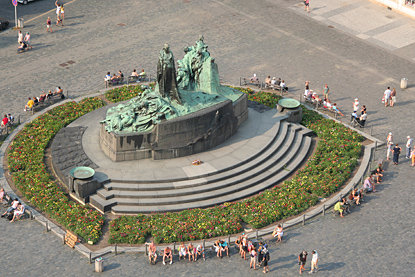 In the center of Prague’s Old Town Square stands a large monument. With the abundance of shops and restaurants on the square, it would be easy to rush by without considering the monument’s significance. The bronze statue portrays an imposing figure standing facing into the wind. His defiant posture contrasts the oppressed Czech people lying at his feet and his opponents huddled to his side. It might come as a surprise to find that the hero of the monument is a household name to most who have studied church history. The statue portrays, Jan Hus (or John Huss), one of the precursors of the Protestant Reformation.
In the center of Prague’s Old Town Square stands a large monument. With the abundance of shops and restaurants on the square, it would be easy to rush by without considering the monument’s significance. The bronze statue portrays an imposing figure standing facing into the wind. His defiant posture contrasts the oppressed Czech people lying at his feet and his opponents huddled to his side. It might come as a surprise to find that the hero of the monument is a household name to most who have studied church history. The statue portrays, Jan Hus (or John Huss), one of the precursors of the Protestant Reformation.
Hus was a preacher, philosopher, professor, and Dean and Rector of Charles University. Hus had been assigned to preach at Prague’s Bethlehem Chapel, an unusual church that was founded with the stipulation that the preaching be done in Czech, the native language of the people. This was a remarkable idea in an era when most services were conducted in Latin.
As a philosophy teacher, Hus was exposed to the writing of John Wycliffe, a philosopher and theologian at Oxford University. Hus enjoyed Wycliffe’s academic writing, so he decided to read his theology. As he absorbed Wycliffe’s ideas, Hus began to question Catholic teachings on subjects such as the nature of the church, purgatory, and transubstantiation. He preached in Bethlehem Chapel against the abuses of the clergy. These were radical ideas, and Hus might have been silenced sooner had he not been such a popular preacher.
In 1414 Hus was invited to the Council of Constance to defend his teaching. Holy Roman Emperor Sigismund promised Hus safe conduct, but the council arrested him when he arrived and tried him as a heretic. Hus was burned at the stake with Wycliffe’s writings used to start the fire. He died singing “Christ, Thou Son of the living God, have mercy on us; Christ, Thou son of the living God, have mercy on me.”
After his death Hus became a national hero, and his teaching spread throughout Bohemia and Moravia. Today, most Czechs seem to have forgotten Hus’ theological ideas, revering him for his contribution to Czech independence (in part because of the Hussite Wars). The monument in Old Town Square has great symbolic value to the Czech people, having been the backdrop for major protests, funeral processions, and celebrations. It’s said that when the Soviet tanks rolled into Old Town Square in 1968, someone blindfolded Hus so he wouldn’t have to bear the pain of another foreign invasion.
Protestants still remember Hus’ part in early stages of the reformation, particularly because of his relationship to Luther. Hus died almost exactly 100 years before Luther nailed his 95 theses to the door in Wittenberg. Luther was immediately accused of being a Hussite. Luther wrote:
“This which has been begun during my lifetime will be completed after my death. St. John Huss prophesied of me when he wrote from his prison in Bohemia, ‘They will roast a goose now (for ‘Huss’ means ‘a goose’), but after a hundred years they will hear a swan sing, and him they will have to endure.’ And that is the way it will be, if God wills.”
Luther’s family crest displayed a swan, and artists often portray him with a swan.
